
There are no secrets in Olafur Eliasson’s art. There are mysteries — plenty of them, piling enigma on top of inscrutability — but no secrets. He happily shows you how he makes his art’s mysteries, which lets you slip comfortably into their dazzling, often spectacular beauty without fear of being duped. Smoke and mirrors proliferate, but you are welcomed in as a full participant in the seductive play. You get space to see and think.
“Olafur Eliasson: OPEN” debuted Sunday in Little Tokyo, where it fills the primary warehouse space at the Geffen Contemporary at MOCA. One among more than 70 exhibitions around Southern California in the Getty Foundation-sponsored “PST Art: Art & Science Collide,” it is scheduled for an exceptionally long run — almost 10 months — closing July 6. Nine recent paintings and 18 light installations, 11 of which were made for the exhibition, comprise a visually, conceptually and perceptually thrilling survey of the Berlin-based, Icelandic Danish artist’s work from the last 20 years.
The enthralling “Pluriverse assembly” is emblematic. A fabric scrim is stretched across nearly the entire width of a large, darkened gallery, and it reaches almost from the floor to the high ceiling. A slowly shifting array of abstract shapes unfurls, sliding almost like an animation of a Surrealist painting by Arshile Gorky or Roberto Matta.
Gold, white and an infinite variety of shades of gray emerge from pitch-black darkness. Occasionally they’re interrupted by bursts of jewel-tone color — ruby, emerald, sapphire, amethyst.
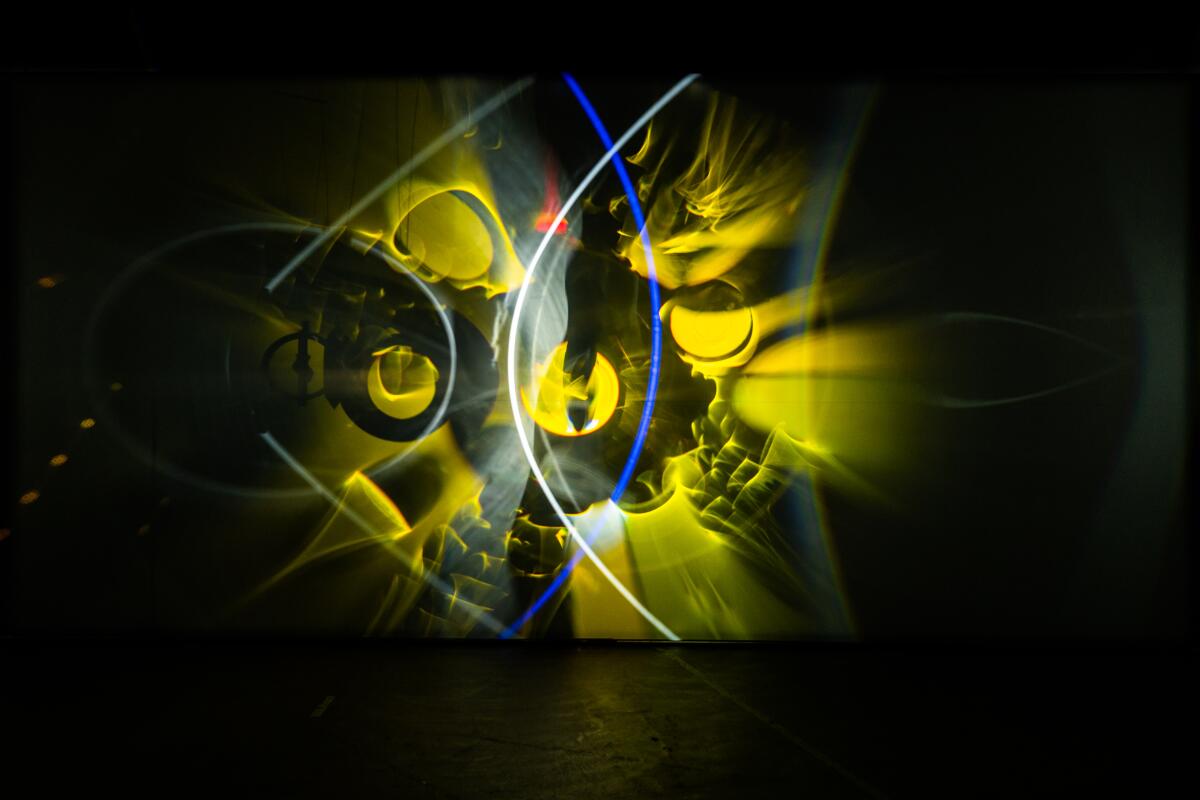
Layered within a darkly atmospheric light, most of the bright moving shapes are organic yet metallic, their edges curved or else blossoming into linear arcs that travel across the room. (Tonalities create illusions of depth.) Like the warped fabric of Albert Einstein’s space-time continuum, the curvature also recalls the famous opening frames of Stanley Kubrick’s “2001: A Space Odyssey,” where the blinding white light of the sun seems to rise from behind the black orb of an Earth buried — and maybe even lost — within the surrounding void of outer space. The planet’s edge is outlined as a glowing crescent, light that binds the two worlds together.
Einstein, Kubrick — Eliasson never lets obscure optical physics swamp the viewer’s experience, frequently nodding to the common imagery of popular culture as a congenial anchor. In a marvelous 2018 installation at the Marciano Art Foundation near Hancock Park, the last substantive time his work was shown in Los Angeles, his projections of highly saturated color were produced by shining intense beams of pure white light through monochrome gels tucked up into the building’s rafters. The method relied on the century-old mechanics of Hollywood’s Technicolor film processes to create an abstract “moving picture” in three-dimensional space.
Sometimes, the shapes in “Pluriverse assembly” suggest familiar objects — a simple light bulb, for instance, or a changing typology of ancient Greek vases, like an amphora or an oenochoe jug. Rather than incandescent tungsten or wine and olive oil, however, these constantly morphing shapes carry sparkling pinpoints of light. The bulb suggests enlightenment, while those old clay vessels, sometimes used as grave markers or funerary offerings, lend a spiritual dimension to Eliasson’s luminescent sight.
Hypnotically gorgeous, the attention-grabbing illuminations eventually give way to a realization that a dimmer level of light is also being cast on the gallery’s side walls — mostly moving arcs and circles, rather like cat’s eyes seen at night. Reflections? Light leakage?
Going over to inspect, one discovers that the work’s flat front scrim is actually a shallow box, with black scrim pulled taut at each side. Through the veiled scrim, some sort of machinery can be glimpsed inside. Go all the way around and the wizard’s curtain is pulled back to reveal a surprising array of mechanisms that create the magical optical effects out front.
What’s most surprising is how low-tech it all is. Some clear glass halos and discs hang in space, suspended on filament. A few standing spotlights, their high-intensity beams trained on pieces of glass, produce the visual spectacle as light bends and shatters.
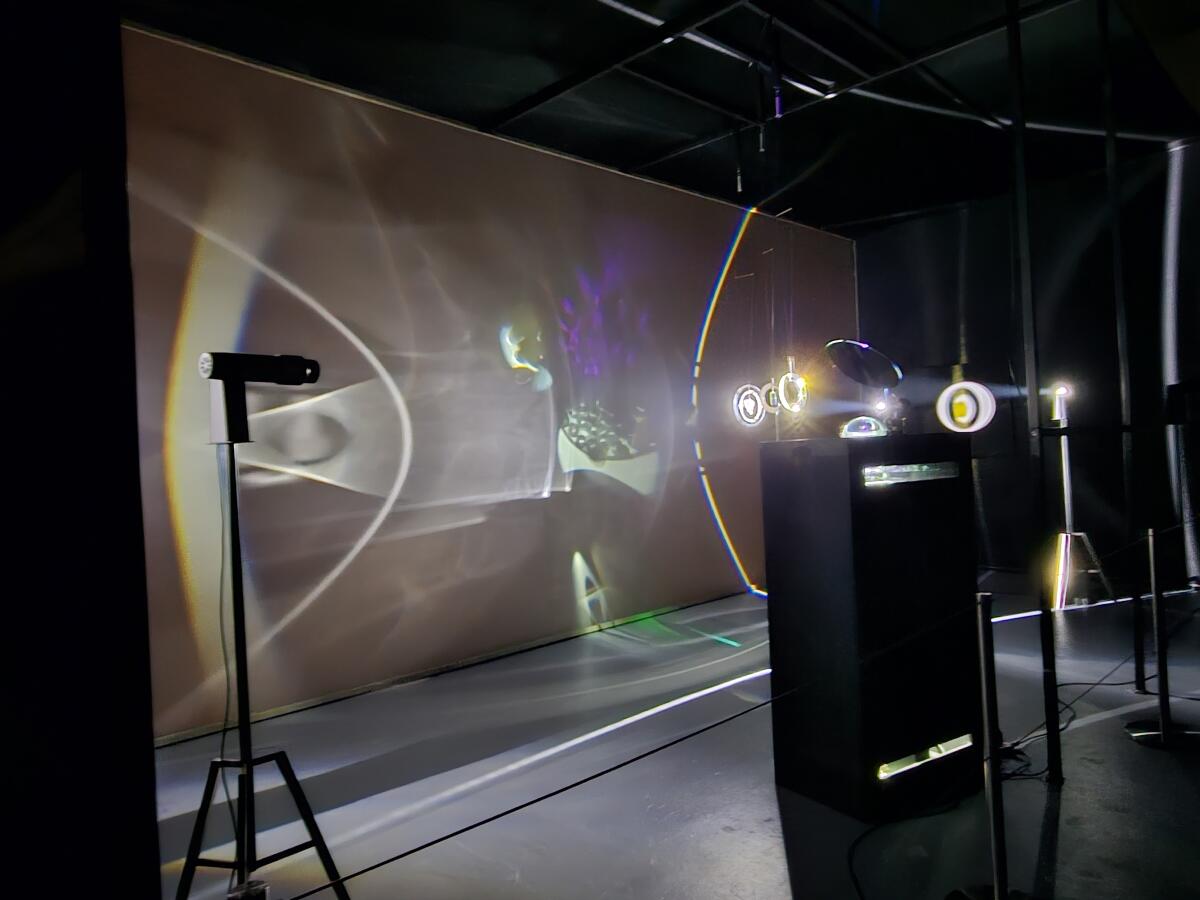
One lamp is trained on a pedestal holding assorted glass lenses and other objects on two small turntables, which rotate at different speeds. (Have you seen those flashy displays of cubic zirconia rings and lab-created gemstone bracelets on broadcast retailer Jewelry TV?) Random object juxtapositions create ever-changing patterns of illumination, which reflect off an angled mirror fixed above and onto the back of the big scrim.
In this back room’s corners, suspended panels further interrupt the perceptual action — at one moment creating what I swear was a passing lozenge-within-a-disc that looked like the CBS eyeball, a well-known corporate trademark, winking. The multiple intimations of television made me smile. Eliasson works with a fabrication team, but the installation’s mechanics have the disorienting feel of an obsessed tinkerer’s haphazard workshop out in the garage, albeit assembled and delivered with sophistication and panache.
Returning to the front to sit on a bench and watch the imaginative spectacle anew becomes an enchanting rather than a puzzling experience. Like being at the movies, the “Pluriverse assembly” gathers up worlds that are human, natural and spiritual — the universe made plural.
Eliasson worked with Museum of Contemporary Art senior curator José Luis Blondet, associate curator Rebecca Lowery and present and past curatorial assistants Emilia Nicholson-Fajardo and Anastasia Kahn. They arranged the exhibition around a central gallery that features a plain rainbow of light arcing across a freestanding back wall. The rainbow backs four tall, mirrored towers out front in the room, configured in the shapes of a triangle, square, rectangle and circle, each raised off the floor on spindly legs. They range from 24 feet to more than 40 feet in height. Walk beneath a tower’s mirrored walls and into its inner sanctum, and assorted optical effects unfold overhead, bathing visitors in their unusual light.
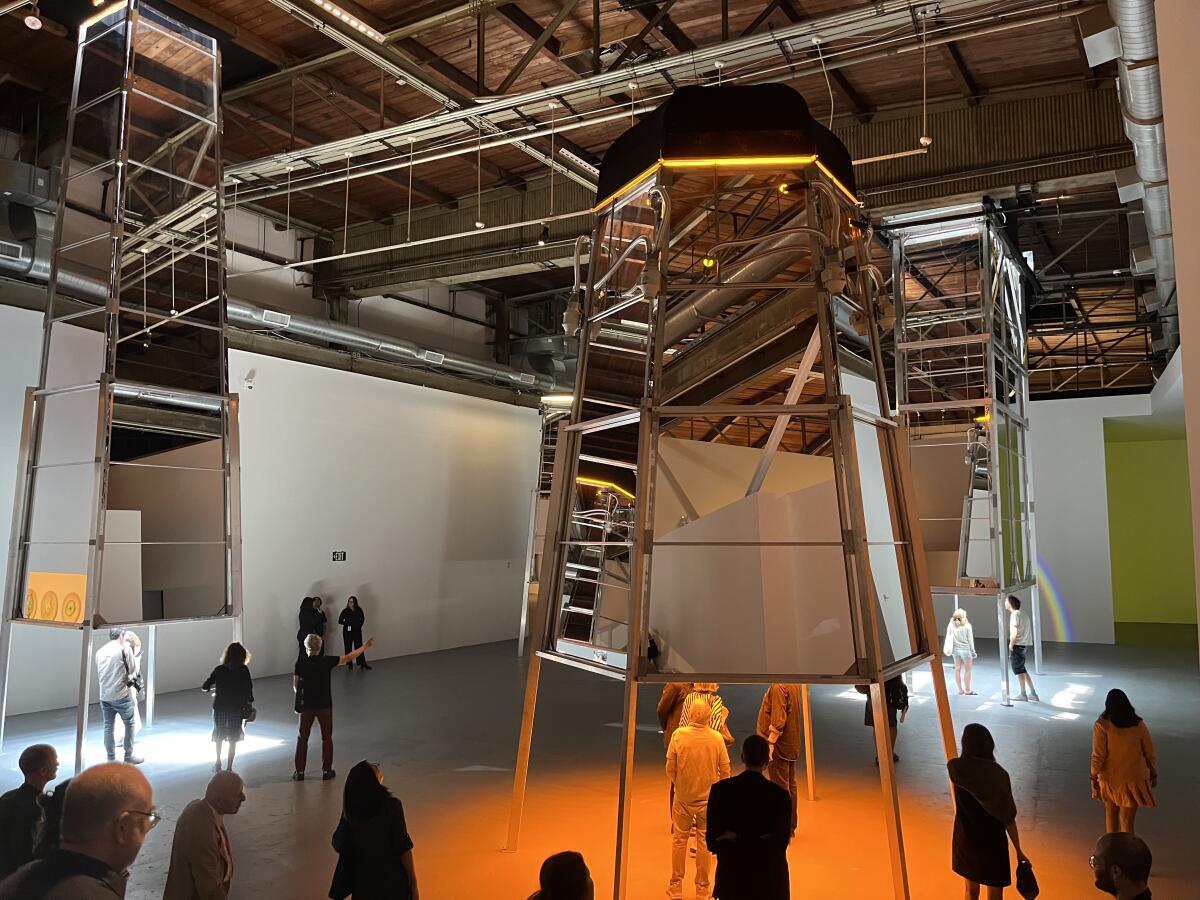
The most unexpected is composed of scavenged plastic grocery bags. They rotate and flutter, their disturbing reflection into mirrored infinity entangled with your own gawking reflection, sinking into a morass of street waste.
Suddenly, the towers’ tall shapes suggest familiar structures — buoys bobbing at sea, warning of hazardous shoals ahead; deep-sea oil rigging, pulling up the fluid that drives the industrial ruin of global warming; the watchtowers surveilling a prison or military installation. You are inside. Exit and walk around in front of a yellow light projected against the rainbow wall’s back side, and your cast shadow mysteriously fragments, like a deck of cards being fanned.
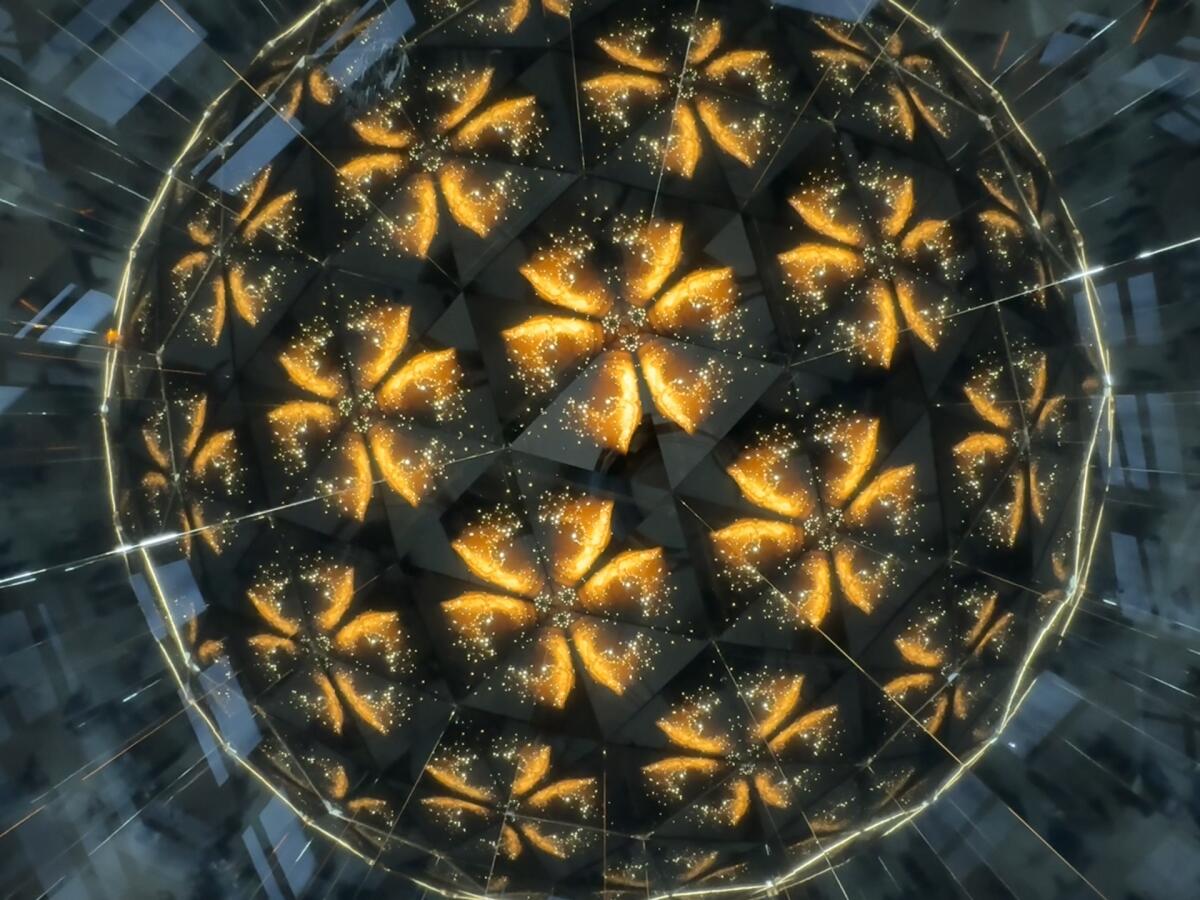
The simplicity of Eliasson’s work is deceptive. In another room, sculptures based on eye-dazzler kaleidoscopes introduce mind-bending meditations on boundless eternity, both molecular and astronomical, natural and industrial, micro and macro, and in ways that Yayoi Kusama’s playful, loosely related mirrored infinity chambers never do. Pressed into service are materials that range from mere water droplets to state-of-the-art polarizing filters. The results prepare the ground for a boggling encounter upstairs on the museum’s mezzanine — an astonishingly plain installation of three mirrored walls.
Those mirrors, reflecting one another in a white-walled interior, transform a modestly scaled architectural space into something like a vast, vacant landscape cribbed from “Dune.” Large, semicircular tubes mounted to the mirrors turn into reflected rings, which appear to float in visual space at topsy-turvy angles. For a moment, it’s hard to know quite where you are and to distinguish up from down. People in the gallery — including you — get visually lassoed by the rings, almost as if being perceptually tethered against the buoyant possibility of floating away.
As always, Eliasson reveals the secret, exposing the space behind each freestanding wall. Their backs are also mirrored, and hefty steel counterweights are holding up the semicircular tubes that protrude out front. Suddenly, the inescapable (if invisible) pull of gravity is emphasized. That’s a fundamental concern of sculpture in every artistic age and culture — its brass ring, if you will — and here it does yeoman’s work in energizing spaces both actual and illusionistic.
Soundless, but titled “The listening dimension,” the installation demands being alert — like a human animal on the prowl, one could say, a beast who depends on being acutely observant for survival. That’s a general thrust of Eliasson’s work, which magnificently extends the lineage of Light and Space art that began in Los Angeles in the 1950s and ’60s with such profound predecessors as John McLaughlin, Robert Irwin and Doug Wheeler.
The MOCA survey is titled “OPEN,” all in caps. Like those earlier artists, Eliasson strives to keep perception from closing down, flattening out into the dull familiarity of debilitating habits — which applies to varieties of experience, whether emotional, political or social. The generosity of such a project can’t be overstated, and it’s nothing short of exhilarating.
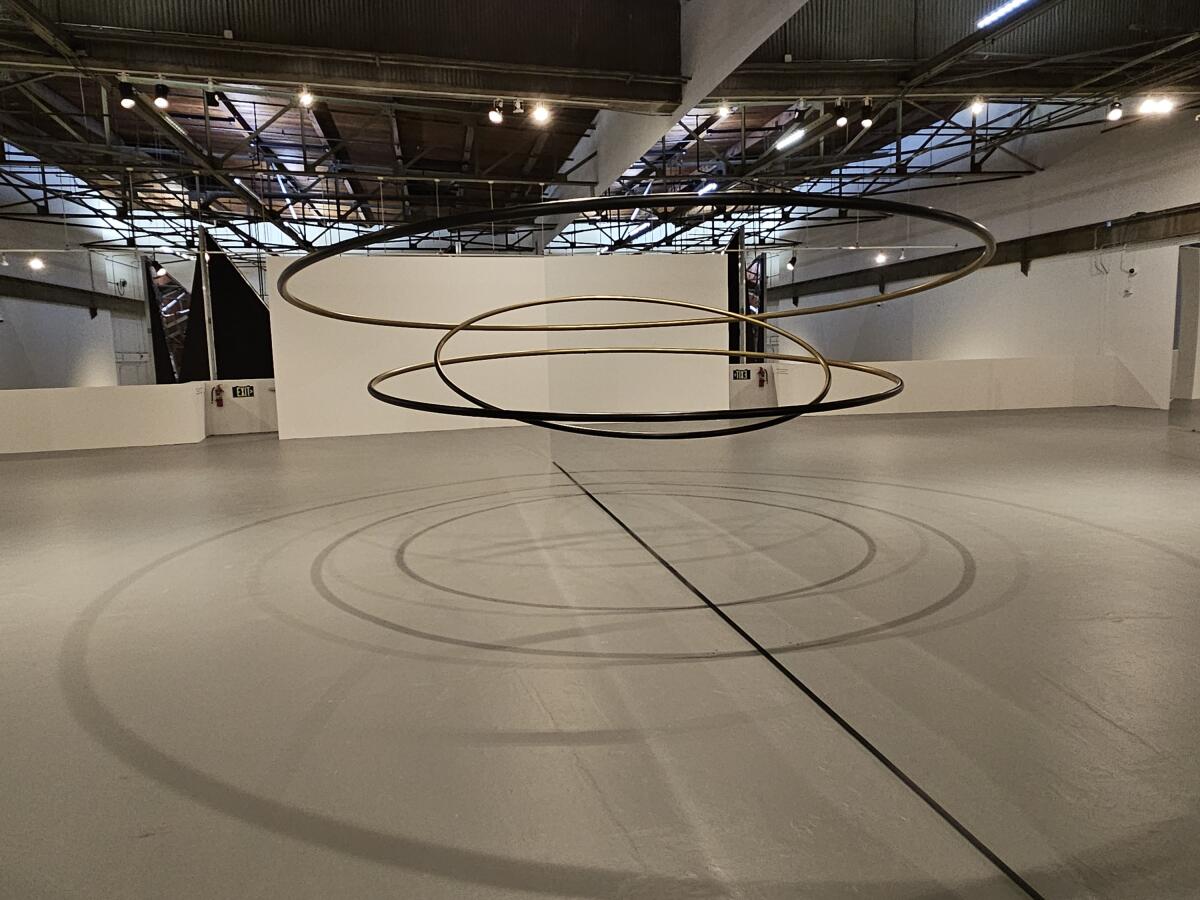
‘Olafur Eliasson: OPEN’
Where: Geffen Contemporary at MOCA, 152 N. Central Ave., Little Tokyo
When: Thursday-Sunday, through July 6
Admission: $18 for adults, $10 for students and seniors older than 65, free for children younger than 12
Info: (213) 626-6222, moca.org